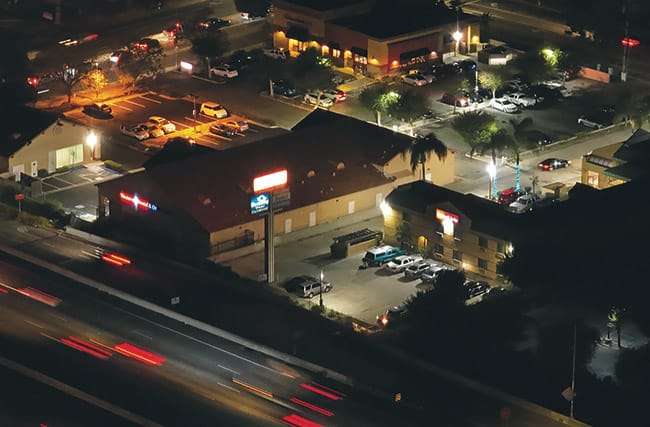Killing brings urgent focus on Claremont area motel crime

by Steven Felschundneff | steven@claremont-courier.com
The killing of a young man at the Claremont Lodge this week has cast a renewed focus on the many problems emanating from the motels adjacent to Indian Hill Blvd. and the 10 Freeway in Claremont.
Criminal activity associated with the Claremont Lodge, Motel 6 and Knight’s Inn motels is nothing new, as anyone who reads the Police Blotter can attest. But Claremont police have noted a marked increase in activity they attribute to Los Angeles County District Attorney George Gascon’s special directive 20-07, which instructed his staff not to prosecute certain misdemeanor crimes.

The City of Claremont is working on a special nuisance ordinance to help curb the criminal activity emanating from the motels near the intersection of Indian Hill Boulevard and the 10 Freeway in Claremont. COURIER photo/Peter Weinberger
One of the crimes covered under the special directive is loitering to commit prostitution, which police say has led to a sharp increase in the sex trade in and around these motels. Beginning in January, Senate Bill 357, which was recently signed into law by Governor Gavin Newsom, will make loitering for prostitution legal in California.
To educate the public about what occurs at Claremont’s southern border, officers from the Pomona Police Department’s Sexual Exploitation Trafficking Team have presented two primers about street prostitution and human trafficking, most recently at the July 7 police commission meeting.
During the meeting, PPD officer Sean Gonzalez painted a stark picture of street sex work in Pomona, which has historically taken place along Holt Avenue, but in recent years has migrated north on Indian Hill Boulevard, reaching the motels in Claremont. The sex trade, including many of the sex acts themselves, often take place in cars along residential streets adjacent to Holt and Indian Hill, he said.
Police said many of the sex workers, both minors and adults, work for pimps engaged in the lucrative business of exploiting them for profit, and some of these mostly young women work against their will.
“Most exploiters have ties to organized crime and criminal street gangs and see the sex industry as less dangerous and more profitable than narcotics or other criminal enterprises,” Gonzalez contended.
Sex workers encompass all ethnicities, ages, genders, and sexual orientations, according to Gonzalez. However, 81% of those arrested by the Pomona Police Department’s Sexual Exploitation Trafficking Team over the last three years are women. They are also overwhelmingly people of color — 59.5% are Black, 26.6% are Hispanic and just 12.4% white.
“Most sex workers enter the lifestyle as minors, with an average age of 13 to 14 years. And talking to the victims, some start as early as 11 or 12,” Gonzalez said, noting that any minor who is in the sex trade is considered a victim of human trafficking.
A companion presentation by Christina Jimenez, who works for the Pomona based nonprofit Project Sister Family Services, focused on the resources available to victims of human trafficking.
Jimenez also works with the Inland Valley Anti-Human Trafficking Task Force, which was established January 2020 to provide resources to adult human trafficking victims and survivors, “to aid them in leaving the life, as well as providing law enforcement with education and resources.”
Once a person expresses a desire to escape their exploiter, they are given help if they agree to the organization’s terms, which include working with a case manager who checks in regularly, Jimenez said. The group can provide emergency shelter in a hotel room for two to three nights, long-term shelter housing for 30 to 90 days, and can then assist with the transition to permanent housing. The task force also provides hygiene products, food, comfortable clothing, and transportation, and can arrange for a return trip home for the victim.
“LAPD human traffic task force has estimated that human trafficking will surpass drug and other large criminal organizations,” Jimenez said. “When we think of drugs and weapons trafficking, those are often one-time transactions. Folks have learned that a human being can be exchanged and sold multiple times in one night. So, we know that is growing.”
According to Jimenez, the National Coalition on Missing and Exploited Children received over 17,000 reports of possible child sex trafficking in 2020, and the average age of a U.S. citizen being recruited is 15 years.
“How did they end up on the street selling sex? Some were abused as children, others ran away from the foster care system, some had parents that sold them into trafficking,” she said.
Children can also be trafficked for forced domestic labor, farm work, restaurant help or even to beg for money.
The Inland Valley task force offers classes on online safety for children because the number one place minors are recruited for trafficking is via social media, including TikTok, Snapchat and Instagram.
Claremont and Pomona police departments’ primary focus is getting exploited minors and adults off the street, followed closely behind by arresting and prosecuting the traffickers. They say one of the most efficient ways to get someone to open up about being trafficked is to arrest him or her for loitering and take them to the controlled space of the police department and offer an avenue out of the lifestyle. This is critical, police say, because on the street that individual is being watched closely and will most often lie about being trafficked.
Following the presentation from Gonzalez, Claremont Police Commission member Nona Tirre asked how SB 357 will impact law enforcement’s ability to bring those being trafficked into the controlled space where they can ask for help.
Gonzalez said after the law goes into effect, police will have no legal right to stop someone for loitering for prostitution, which will result in fewer contacts and less opportunity to get victims into safe environments to determine whether he or she is being trafficked.
Commissioner Becky Margiotta said prostitution only happens when a person agrees to buy sex, but the focus of the discussion is on the sex worker.
“I can’t get it to square in my head how a victim could be an offender,” Margiotta said. “I guess I am just confused why anyone would arrest victims in the first place.
“If someone is a rape victim, we don’t arrest them to help them. I don’t understand why this [SB 357] is being presented as problematic. I don’t understand why the focus isn’t on arresting the people putting [women] in that situation and exploiting them,” she said.
“Do you think the owners [of the motels] are knowingly profiting and are aware of trafficking going on in their properties?” commissioner Caleb Mason asked.
Mason noted that no representative from the motels had called in, or come to the police commission meetings, and that there have been numerous opportunities to get community feedback.
On Wednesday, the COURIER called the three problematic motels to ask what management was doing to actively combat sex work at the properties.
A person called Frankie who answered the phone at Motel 6 transferred the call to a “DM,” who did not pick up the phone. A man at the Knights Inn said the question could only be answered by a manager, then hung up when asked for the manager’s name. At the Claremont Lodge, a woman named Jessica said she didn’t know anything about sex work at the motel and recommended calling back to speak with a manager, who had left for the day.
To help combat sex trade, as well as other criminal behavior at the motels, the city is working on a special nuisance ordinance, and is currently gathering input from stakeholders and those in the motel industry. The city tentatively plans to present the ordinance to the planning commission and city council this fall, according to City Attorney Alisha Patterson.
That ordinance would be part of a three-pronged approach combined with the threat of a “red-light abetment lawsuit,” and a stepped up focus on ensuring compliance of existing rules at the motels, which could include both policing and code enforcement.










0 Comments